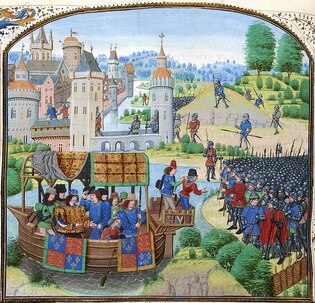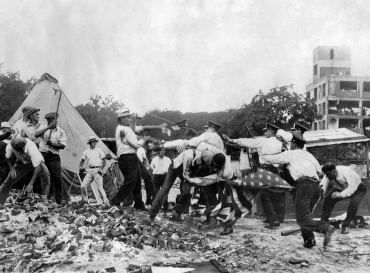 Richard II meets the rebels on 14 June 1381 in a miniature from a 1470s copy of Jean Froissart's Chronicles.
Richard II meets the rebels on 14 June 1381 in a miniature from a 1470s copy of Jean Froissart's Chronicles. Inspired by the sermons of the radical cleric John Ball and led by Wat Tyler, a contingent of Kentish rebels advanced on London. They were met at Blackheath by representatives of the royal government, who unsuccessfully attempted to persuade them to return home. King Richard II, then aged 14, retreated to the safety of the Tower of London, but most of the royal forces were abroad or in northern England. On 13 June, the rebels entered London and, joined by many local townsfolk, attacked the gaols, destroyed the Savoy Palace, set fire to law books and buildings in the Temple, and killed anyone associated with the royal government. The following day, Richard met the rebels at Mile End and acceded to most of their demands, including the abolition of serfdom. Meanwhile, rebels entered the Tower of London, killing the Lord Chancellor and the Lord High Treasurer, whom they found inside.
On 15 June, Richard left the city to meet Tyler and the rebels at Smithfield. Violence broke out, and Richard's party killed Tyler. Richard defused the tense situation long enough for London's mayor, William Walworth, to gather a militia from the city and disperse the rebel forces. Richard immediately began to re-establish order in London and rescinded his previous grants to the rebels. The revolt had also spread into East Anglia, where the University of Cambridge was attacked and many royal officials were killed. Unrest continued until the intervention of Henry Despenser, who defeated a rebel army at the Battle of North Walsham on 25 or 26 June. Troubles extended north to York, Beverley and Scarborough, and as far west as Bridgwater in Somerset. Richard mobilised 4,000 soldiers to restore order. Most of the rebel leaders were tracked down and executed; by November, at least 1,500 rebels had been killed.
The Peasants' Revolt has been widely studied by academics. Late 19th-century historians used a range of sources from contemporary chroniclers to assemble an account of the uprising, and these were supplemented in the 20th century by research using court records and local archives. Interpretations of the revolt have shifted over the years. It was once seen as a defining moment in English history, but modern academics are less certain of its impact on subsequent social and economic history. The revolt heavily influenced the course of the Hundred Years' War, by deterring later Parliaments from raising additional taxes to pay for military campaigns in France. The revolt has been widely used in socialist literature, including by the author William Morris, and remains a potent political symbol for the political left, informing the arguments surrounding the introduction of the Community Charge in the United Kingdom during the 1980s.

 RSS Feed
RSS Feed